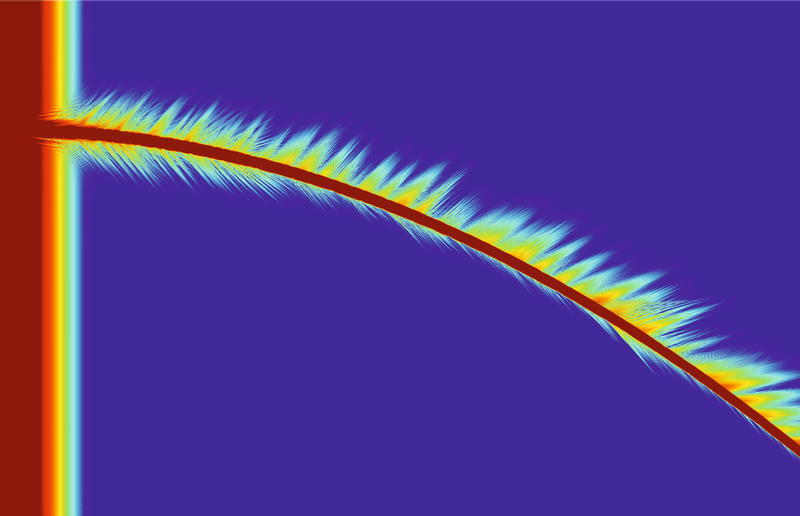Bending X Rays on a Chip
Guiding x rays is usually a straight-line affair, but researchers have now created a curved waveguide, miniaturized to fit on a chip. The waveguide is a nanoscale channel cut into a small metal plate, and it preserves the narrow, coherent x-ray beams that are required for high-resolution x-ray imaging. The device can deflect a beam by up to 30 degrees and can provide control over the beam direction on smaller scales than conventional equipment allows. The waveguide could improve the resolution of both nanoscale x-ray images and ultrafast probes of chemical reactions.
Given their short wavelengths, x rays are a natural choice for imaging small-scale structure, especially when the waves are coherent—meaning their peaks and troughs are nearly synchronized, like laser light. For example, Tim Salditt of the University of Göttingen in Germany and his colleagues recently produced holographic images of bacterial cells with 50-nanometer resolution [1]. However, their setup could have been simplified and produced even higher resolution data if they had curved x-ray waveguides available to guide more beams toward the cell.
X-ray tools are challenging to develop because the waves have such high energies and can usually only be reflected at very shallow angles. When researchers need to bend or delay an x-ray beam for an advanced imaging technique, they reflect the beam off a crystal or perhaps use a long glass capillary to deflect the beam by up to a few degrees. These techniques require large setups and, in the case of capillaries, do not maintain the coherent beams required of many high-resolution imaging techniques. Improved x-ray waveguides would both miniaturize and simplify the optical setup required for narrow, intense x-ray beams.
Now Salditt and his colleagues have guided x rays along a curved waveguide in a small metal chip, deflecting the radiation by up to 30 degrees over a distance of 5 millimeters. The waveguide improves the coherence of partially coherent waves and shrinks the beam width to about 100 nanometers.
The waveguide is a narrow, open groove or channel cut into a solid piece of metal. Most of the beam remains guided within the channel as long as the x rays experience only glancing-angle reflections along the walls. The channel must be narrow enough that the reflection angles are below the critical angle of total reflection, which is less than 1 degree. This requirement translates to a channel width of 100 nanometers.
The team arranged for a variety of these curving channels to be lithographically etched onto two 5-millimeter-square plates made of tantalum, a high-density metal that has a relatively large critical angle but also a high x-ray absorption. To maximize x-ray throughput, the team used intense beams generated at the DESY synchrotron facility in Hamburg, Germany, and, in a second test, the European Synchrotron Radiation Facility in France. They focused the beams to a width of a few hundred nanometers at the entrances of the waveguides.
Salditt and his colleagues tested increasingly curvy waveguides and found that they could bend beams by up to 30 degrees over 5 millimeters. But beyond this angle the x rays were almost entirely lost into the tantalum, either through absorption or by “tunneling” through the waveguide walls.
Salditt hopes to fine-tune the chip material and the x-ray energy in the future in order to curve x rays by 90 or even 180 degrees. By imaging an object from several angles with a variety of curved waveguides, the resolving power of x-ray imaging could be more than doubled, Salditt says, just as increasing the aperture of a telescope increases its resolution. More importantly, these curvy and customizable waveguides bring traditional x-ray optics down to the size of just a few millimeters.
This new work “changes x-ray optics from fairly [large-scale] devices to miniature devices, with all the attendant advantages,” says Sunil Sinha of the University of California, San Diego. Ralf Röhlsberger of DESY agrees, saying that the work is a “significant addition” because it allows the direction of x rays to be tailored in a “very flexible fashion.” He suggests that these waveguides on a chip could be used to monitor chemical reactions triggered by nanoparticles or to image single biological cells with very high resolution.
This research is published in Physical Review Letters.
–Tamela Maciel
Tamela Maciel is a freelance science writer in Leicester, UK.
References
- M. Bartels, M. Krenkel, J. Haber, R. N. Wilke, and T. Salditt, “X-Ray Holographic Imaging of Hydrated Biological Cells in Solution,” Phys. Rev. Lett. 114, 048103 (2015).





